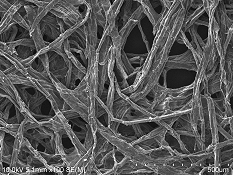Press Release
A Battery Made of Wood?
Wood fibers help nano-scale batteries keep their structure
FOR IMMEDIATE RELEASE June 19, 2013
CONTACT:
Martha Heil
301 405 0876
mjheil@umd.edu

NOTE TO EDITORS: VIDEO AND PHOTOS AVAILABLE AT http://www.nanocenter.umd.edu/news/news_story.php?id=7451
COLLEGE PARK --A sliver of wood coated with tin could make a tiny, long-lasting, efficient and environmentally friendly battery.
But don’t try it at home yet– the components in the battery tested by scientists at the University of Maryland are a thousand times thinner than a piece of paper. Using sodium instead of lithium, as many rechargeable batteries do, makes the battery environmentally benign. Sodium doesn’t store energy as efficiently as lithium, so you won’t see this battery in your cell phone -- instead, its low cost and common materials would make it ideal to store huge amounts of energy at once – such as solar energy at a power plant.
Existing batteries are often created on stiff bases, which are too brittle to withstand the swelling and shrinking that happens as electrons are stored in and used up from the battery. Liangbing Hu, Teng Li and their team found that wood fibers are supple enough to let their sodium-ion battery last more than 400 charging cycles, which puts it among the longest lasting nanobatteries.
"The inspiration behind the idea comes from the trees," said Hu, an assistant professor of materials science. "Wood fibers that make up a tree once held mineral-rich water, and so are ideal for storing liquid electrolytes, making them not only the base but an active part of the battery."
Lead author Hongli Zhu and other team members noticed that after charging and discharging the battery hundreds of times, the wood ended up wrinkled but intact. Computer models showed that that the wrinkles effectively relax the stress in the battery during charging and recharging, so that the battery can survive many cycles.
"Pushing sodium ions through tin anodes often weaken the tin’s connection to its base material,” said Li, an associate professor of mechanical engineering. "But the wood fibers are soft enough to serve as a mechanical buffer, and thus can accommodate tin’s changes. This is the key to our long-lasting sodium-ion batteries."
The team’s research was supported by the University of Maryland and the U.S. National Science Foundation.
--end—
More Information:
See the full paper at:
"Tin Anode for Sodium-Ion Batteries Using Natural Wood Fiber as a Mechanical Buffer and Electrolyte Reservoir," Hongli Zhu, Zheng Jia, Yuchen Chen, Nicholas J. Weadock, Jiayu Wan, Oeyvind Vaaland, Xiaogang Han, Teng Li, and Liangbing Hu, Nano Letters, 2013
About the A. James Clark School of Engineering
The University of Maryland’s A. James Clark School of Engineering is a premier program, ranked among the top 20 in the world. Located just a few miles from Washington, D.C., the Clark School is at the center of a constellation of high-tech companies and federal laboratories, offering students and faculty access to unique professional opportunities.
Our broad spectrum of academic programs, including the world’s only accredited undergraduate fire protection engineering program, is complemented by a vibrant entrepreneurial ecosystem, early hands-on educational experiences, and participation in national and international competitions.
The Clark School is leading research advancements in aerospace, bioengineering, robotics, nanotechnology, disaster resilience, energy and sustainability, and cybersecurity. From the universal product code to satellite radio, SMS text messaging to the implantable insulin pump, our students, faculty, and alumni are engineering life-changing innovations for millions. Learn more at www.eng.umd.edu.